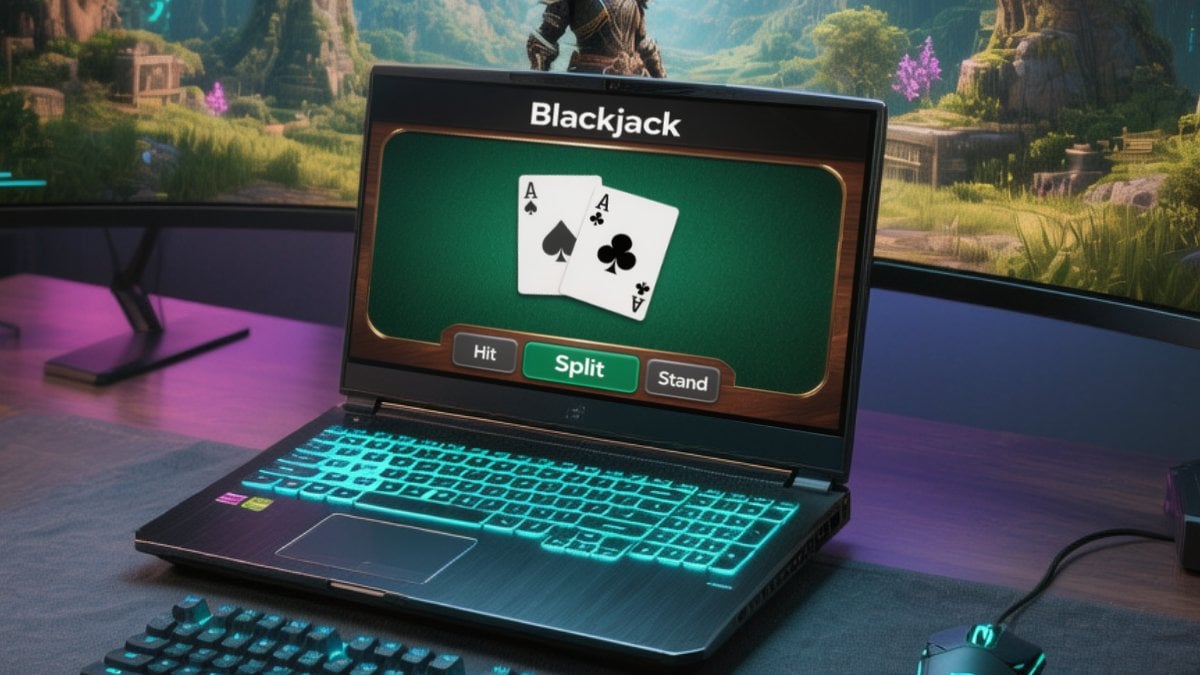
Splitting pairs is one of blackjack’s most important moves — a correct split can turn a losing round into a winning opportunity, while a poor one can drain your stack fast.
The mechanism works because blackjack is a game of probabilities, not impulse. Splitting breaks one tough decision into two manageable ones, giving you more control over weak or uncertain hands. Knowing when to split requires an understanding of math, table rules, and dealer behavior.
What Does Split Mean in Blackjack?
In blackjack, a split occurs when your first two cards are of equal rank—like two 8s or two Kings—and you choose to divide them into separate hands. This decision costs an extra wager equal to your original bet. Each new hand then draws its own cards, giving you two independent chances to beat the dealer.
The power of splitting lies in changing your position in the round. Splitting a notoriously weak hand can create two stronger hands instead of one losing one. Still, not every pair deserves this treatment. The correct choice depends on the table’s rules and the type of blackjack being played, especially across modern types of blackjack where variations like European, Spanish 21, and Bitcoin-based blackjack tables use slightly different mechanics.
Basic Blackjack Split Rules Explained
Casinos follow specific conditions that affect how the move plays out. These rules influence how much you can bet, how many hands you can create, and when the dealer stops the action.
- Equal Wager Requirement. When you split, you must match your original bet to form a second hand. Both are then played separately against the dealer.
- Resplitting Restrictions. Some casinos let you split again if another identical pair appears, while others limit it to one split per round. Always check the house policy first.
- Aces Are Special. Most rules allow only one extra card for each split Ace. This prevents instant blackjacks but still gives players a shot at two strong hands.
- Doubling Options. Certain tables permit doubling down after a split, especially on non-Ace pairs. That flexibility changes the value of some borderline decisions.
- Blackjack Payout Differences. A 21 made after splitting doesn’t count as a natural blackjack. Instead, it pays the standard 1:1 rather than the 3:2 bonus.
Grasping these mechanics is essential before judging when a split gives you an edge, since small rule variations can shift the odds in your favor or turn a smart move into a costly one.
When Should You Split in Blackjack?
The goal isn’t to play every pair the same way but to recognize which situations create better expected outcomes. It depends on both your cards and the dealer’s upcard, as each combination carries its own probability of success.
Strong split opportunities appear when your current total offers poor winning odds, but can become favorable through division. Take two 8s, for instance—together they form 16, a losing total against most dealer cards. Split them, and you start two new hands that each have a chance to land 18 or 19 instead. In contrast, a pair of 10s should almost never be split, since 20 already beats nearly every dealer outcome.
Casinos featured on top-rated blackjack sites often showcase rule variations that influence when these optimal splits occur.
Blackjack Hands You Should Always Split
Certain pairs perform best when divided, no matter the casino or rule variation. These situations rely on math, not instinct, and they give players the highest chance to turn an awkward hand into a strong position.
- Aces (A-A): Always split aces. Each one starts a new hand with a powerful opening card and strong potential to reach 21. Most tables allow only one extra card per Ace, but even that limitation still favors the player.
- Eights (8-8): A total of sixteen is among blackjack’s weakest positions. Splitting eights converts that losing hand into two new opportunities, both statistically stronger than standing or hitting.
- Nines (9-9): This split depends slightly on the dealer’s card but generally holds up against weaker dealer totals such as 6, 8, or 9. When the dealer shows 7, keeping 18 is often better, but in most other cases, two 9s give you more leverage.
- Sevens (7-7): When the dealer’s card is between 2 and 7, splitting sevens helps you stay ahead before the dealer completes their hand. It’s one of the most reliable moves against small upcards.
These pairs demonstrate how probability favors division over hesitation, and recognizing them during live play builds consistency and helps maintain long-term balance across sessions.
Blackjack Hands You Should Never Split
Some pairs may look promising, but the numbers tell another story. Splitting them often breaks up a strong position or creates weaker totals that struggle to win. Avoiding these moves keeps your edge intact and limits unnecessary losses.
- Tens (10-10): Twenty is already near-perfect. Breaking it into two weaker hands wastes one of blackjack’s best totals.
- Fives (5-5): This pair totals ten—a prime setup for doubling down. Splitting removes that advantage and turns a winning situation into two underpowered hands.
- Fours (4-4): Only split when the dealer shows a 5 or 6, as the math supports the move there. Otherwise, hit or double instead of dividing.
- Face Cards (K-Q, Q-J, etc.): These count as tens, meaning the same logic applies. Keeping them together preserves your strong total and reduces risk.
Learning which hands to leave alone is as important as knowing when to act. Every avoided mistake adds up, protecting gains and keeping play mathematically grounded.
How Dealer Cards Affect Your Split Decisions
Dealer upcards control much of a player’s decision-making in blackjack, and splitting is no exception. The value showing on the dealer’s card often dictates how aggressive or conservative your move should be. When the dealer appears weak—showing a 4, 5, or 6—you can split more freely. When they hold a power card like 9, 10, or Ace, it’s usually safer to stay cautious.
A pair of 6s may be worth splitting against a dealer’s 4 or 5, but not against an Ace. The reasoning is simple: when the dealer’s upcard signals a likely bust, dividing your hand increases the total amount in play while the odds still lean in your favor. On strong dealer cards, splitting weaker pairs usually creates extra risk with little return.
Games available through online blackjack for real money feature multiple variations of dealer behavior, including soft-17 rules and re-split conditions. Learning how those small adjustments affect split value turns a standard table choice into an informed, tactical move.
Splitting Aces, 10s, and Other Tricky Hands
Some blackjack pairs require extra care. Their value depends heavily on context, and even small changes in the dealer’s card or house rules can swing the math either way.
- Aces (A-A): Always divide aces unless the rules forbid it. Starting with two powerful cards gives you two hands that can both reach 21. Even if each receives only one card, the statistical gain outweighs the restriction.
- Tens (10-10): Resist the urge to split. Twenty beats most dealer totals, and dividing the pair only reduces your advantage. Keeping them together is almost always correct.
- Nines (9-9): This pair performs best when the dealer shows 6, 8, or 9, but stands against a 7. The decision balances on narrow margins, so reading the dealer’s strength is critical.
- Fours (4-4): Only consider splitting if doubling after split is allowed and the dealer holds a 5 or 6. In most cases, hitting yields better expected value.
- Fives (5-5): Treat them as a ten and double instead of splitting. Breaking them up removes one of the most favorable totals in the game.
These examples show that not every split follows a fixed rule. Understanding when math supports deviation—and when it doesn’t—defines skilled play more than any single tactic.
How Blackjack Odds Charts Help
A blackjack odds chart acts as a player’s visual reference for making statistically correct decisions, including when to split pairs. These charts map every possible combination of player hands against dealer upcards, showing whether the optimal move is to hit, stand, double, or split.
Charts vary depending on the rules of the game—some account for multiple decks, others for whether the dealer hits on soft 17. Despite those small adjustments, the principle stays consistent: they remove emotion from decision-making. Having one nearby keeps you focused on long-term probability rather than instinct or guesswork.
For those exploring different blackjack variants, odds charts offer a clear way to compare strategies across tables. Whether you’re in a live casino or on an online platform, relying on math-backed visuals builds stronger habits and steadier outcomes. Over time, memorizing the chart turns correct play into muscle memory.
Wrapping up – How and When to Split Pairs in Blackjack
Splitting pairs is one of blackjack’s most technical decisions, requiring calculation before courage. Every move demands awareness of the table’s rhythm, the dealer’s position, and the numbers that decide long-term success.
A player who studies those relationships starts to act with precision rather than impulse. This decision teaches patience. Over many hands, patterns appear, probabilities shift, and the best choices become clearer.
Each time the opportunity to split appears, it offers another chance to practice measured play and strengthen the habits that separate disciplined strategy from simple reaction.







